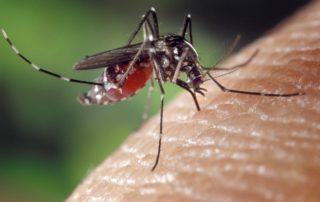Widespread EEEV-Positive Mosquitoes across Northeast CT
NDDH Provides Prevention Tips to Avoid Mosquito-Transmitted Illness
BROOKLYN – The Connecticut Agricultural Experiment Station (CAES) has identified
Eastern Equine Encephalitis virus (EEEV) positive mosquitoes from testing sites in eight CT municipalities including Hampton, Killingly, Thompson, and Woodstock.
Eastern Equine Encephalitis virus (EEEV) is spread to people through the bite of infected mosquitoes.
According to the Centers for Disease Prevention and Control (CDC), EEEV infections can result in fever, chills, body aches, and joint pain, or neurologic disease with symptoms that may include fever, headache, vomiting, diarrhea, seizures, behavioral changes, drowsiness, and coma. In infants, neurologic disease often occurs soon after onset; in older children and adults, encephalitis may occur after several days of illness. The type of illness will depend on the age of the person and other factors.
Most people infected with EEEV do not develop symptoms. For those who develop symptoms, the time from infected mosquito bite to onset of illness (incubation period) ranges from 4 to 10 days.
While EEEV infections among humans are rare in the United States with an average of seven cases reported each year, it is still important to take steps to prevent being bitten by mosquitoes to reduce the risk of infection. There is no vaccine to prevent or medicine to treat EEEV infection. Early recognition and prompt supportive treatment can lower the risk of complications and death.
“The appearance of EEEV in mosquitoes from across the region indicates that all towns in the northeast are likely to have EEEV activity.” said Sue Starkey, Director of Health at the Northeast District Department of Health. “Everyone should take practical steps to avoid being bitten by mosquitoes.”
SWAT is an easy acronym to remember to prevent mosquito bites:
- Screens on doors and windows should be tight-fitting and in good repair; also use mosquito netting when sleeping outdoors or in an unscreened structure and to protect small babies when outdoors.
- Wear shoes, socks, long pants, and a long-sleeved shirt when outdoors for long periods of time, or when mosquitoes are more active. Clothing should be light colored and made of tightly woven materials that keep mosquitoes away from the skin.
- Apply EPA-approved insect repellent according to instructions when going outdoors and minimize time outdoors between dusk and dawn when mosquitoes are most active.
- Toss any standing water that may be collecting on your property. Water in wading pools, bird baths, buckets, barrels, flowerpots, pet dishes, and tire swings should be changed or emptied regularly. Clogged roof gutters should be cleaned.
Connecticut Mosquito Management Program
The response to mosquito transmitted diseases in Connecticut is a collaborative inter-agency effort involving the Department of Energy and Environmental Protection (DEEP), the Connecticut Agricultural Experiment Station (CAES) the Department of Public Health (DPH), the Department of Agriculture and the Department of Pathobiology at the University of Connecticut (UCONN). These agencies are responsible for monitoring mosquito populations and the potential public health threat of mosquito-borne diseases.
The CAES maintains a network of 108 mosquito-trapping stations in 88 municipalities throughout the state. CAES begins mosquito trapping and testing in June and continues into October. Positive findings are reported to local health departments and on the CAES website.
For information on EEEV and other mosquito-borne diseases, what can be done to prevent getting bitten by mosquitoes, the latest mosquito test results, and human infections, visit the Connecticut Mosquito Management Program website.



